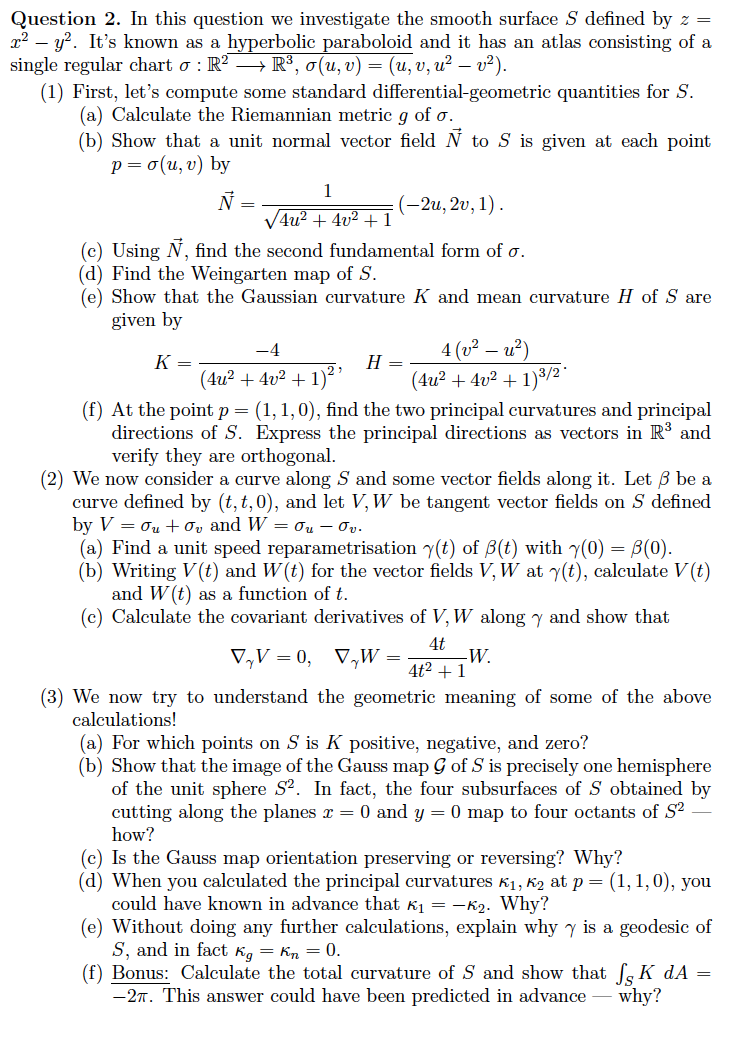Question 2. In this question we investigate the smooth surface S defined by z = r² - y². It's known as a hyperbolic paraboloid and it has an atlas consisting of a single regular chart σ : R² → R³, o(u, v) = (u, v, u² − v²). (1) First, let's compute some standard differential-geometric quantities for S. (a) Calculate the Riemannian metric g of σ. (b) Show that a unit normal vector field N to S is given at each point p = o(u, v) by Ñ 1 √4u² + 4v² + 1 (c) Using №, find the second fundamental form of σ. (-2u, 2v, 1).
Question 2. In this question we investigate the smooth surface S defined by z = r² - y². It's known as a hyperbolic paraboloid and it has an atlas consisting of a single regular chart σ : R² → R³, o(u, v) = (u, v, u² − v²). (1) First, let's compute some standard differential-geometric quantities for S. (a) Calculate the Riemannian metric g of σ. (b) Show that a unit normal vector field N to S is given at each point p = o(u, v) by Ñ 1 √4u² + 4v² + 1 (c) Using №, find the second fundamental form of σ. (-2u, 2v, 1).
Advanced Engineering Mathematics
10th Edition
ISBN:9780470458365
Author:Erwin Kreyszig
Publisher:Erwin Kreyszig
Chapter2: Second-order Linear Odes
Section: Chapter Questions
Problem 1RQ
Related questions
Question
100%
Need help with (2) (c). Please explain each step and neatly type up. Thank you :)

Transcribed Image Text:Question 2. In this question we investigate the smooth surface S defined by z =
x² - y². It's known as a hyperbolic paraboloid and it has an atlas consisting of a
single regular chart σ : R² → R³, o(u, v) = (u, v, u² − v²).
(1) First, let's compute some standard differential-geometric quantities for S.
(a) Calculate the Riemannian metric g of o.
(b) Show that a unit normal vector field Ñ to S is given at each point
p = o(u, v) by
1
√4u² + 4v² + 1
(c) Using №, find the second fundamental form of o.
(d) Find the Weingarten map of S.
(e) Show that the Gaussian curvature K and mean curvature H of S are
given by
K =
Ñ
=
-4
"
(4u²+ 4v² + 1)²
(-2u, 2v, 1).
H =
4 (v² — u²)
(4u² +4v²+1)³/2*
(f) At the point p = (1, 1, 0), find the two principal curvatures and principal
directions of S. Express the principal directions as vectors in R³ and
verify they are orthogonal.
(2) We now consider a curve along S and some vector fields along it. Let 3 be a
curve defined by (t, t,0), and let V, W be tangent vector fields on S defined
by V = O₂ + O₂, and W = ou - ov.
(a) Find a unit speed reparametrisation y(t) of (t) with y(0) = 3(0).
(b) Writing V(t) and W(t) for the vector fields V, W at y(t), calculate V (t)
and W(t) as a function of t.
(c) Calculate the covariant derivatives of V, W along y and show that
4t
4t² + 1
V₁V=0, V₂W =
-W.
(3) We now try to understand the geometric meaning of some of the above
calculations!
(a) For which points on S is K positive, negative, and zero?
(b) Show that the image of the Gauss map G of S is precisely one hemisphere
of the unit sphere S². In fact, the four subsurfaces of S obtained by
cutting along the planes x = 0 and y = 0 map to four octants of S²
how?
(c) Is the Gauss map orientation preserving or reversing? Why?
(d) When you calculated the principal curvatures K₁, K₂ at p = (1, 1, 0), you
could have known in advance that K₁ = -K₂. Why?
(e) Without doing any further calculations, explain why is a geodesic of
S, and in fact Kg = kn = 0.
(f) Bonus: Calculate the total curvature of S and show that J K dA =
-2. This answer could have been predicted in advance - why?
Expert Solution
This question has been solved!
Explore an expertly crafted, step-by-step solution for a thorough understanding of key concepts.
Step by step
Solved in 6 steps with 6 images

Recommended textbooks for you

Advanced Engineering Mathematics
Advanced Math
ISBN:
9780470458365
Author:
Erwin Kreyszig
Publisher:
Wiley, John & Sons, Incorporated

Numerical Methods for Engineers
Advanced Math
ISBN:
9780073397924
Author:
Steven C. Chapra Dr., Raymond P. Canale
Publisher:
McGraw-Hill Education

Introductory Mathematics for Engineering Applicat…
Advanced Math
ISBN:
9781118141809
Author:
Nathan Klingbeil
Publisher:
WILEY

Advanced Engineering Mathematics
Advanced Math
ISBN:
9780470458365
Author:
Erwin Kreyszig
Publisher:
Wiley, John & Sons, Incorporated

Numerical Methods for Engineers
Advanced Math
ISBN:
9780073397924
Author:
Steven C. Chapra Dr., Raymond P. Canale
Publisher:
McGraw-Hill Education

Introductory Mathematics for Engineering Applicat…
Advanced Math
ISBN:
9781118141809
Author:
Nathan Klingbeil
Publisher:
WILEY

Mathematics For Machine Technology
Advanced Math
ISBN:
9781337798310
Author:
Peterson, John.
Publisher:
Cengage Learning,

